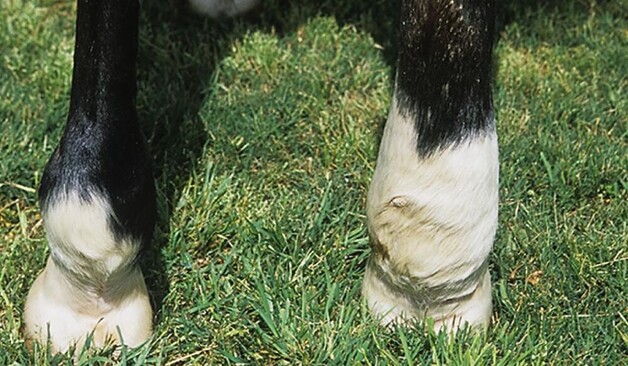In the last year we have seen an increasing number of cases of horses presenting with a very swollen leg that are dramatically lame. This condition has a number of names - big leg, cellulitis or lymphangitis.
As horses have no soft tissue or muscle in their lower legs, any sort of trauma can cause swelling. This swelling is mostly soft to feel and horses can walk or show only minor lameness. This sort of swelling will go away with exercise (which moves the fluid back into circulation) or responds to anti inflammatory drugs. Horses with this ‘big leg’ condition are very different in their presentation.
Horses with big leg/lymphangitis present with an acutely swollen leg from the knee or hock down to the coronet. It is most often seen in hind legs but can occur in front legs. Swelling often extends above the hock to the gaskin area. The degree of lameness is severe (three legged lame). Horses often have an elevated temperature and consequently will be depressed and off feed. The leg is hot and tight and horses do not like it being examined or touched.
The underlying issue is thought to be a bacterial infection within the leg - there are often no wounds or breaks in the skin to signal where this infection has entered from. The bacteria may arrive in the bloodstream and lodge in the leg. They mount an acute response with severe inflammation, swelling heat and pain. The inflammation is such that it blocks the small vessels that drain fluid back into circulation (lymph system). This insufficient lymph drainage causes fluid to build up making the swelling worse. Horses are very lame and reluctant to move so this also impedes fluid movement back into circulation. The swelling can be so great that it can block important blood supply into the leg leading to tissue death. The whole condition is a cycle of swelling and fluid retention causing more fluid retention.
These horses constitute somewhat of an emergency and treatment should be started as soon as possible. Aggressive intravenous broad spectrum antibiotic therapy is needed. Intravenous pain relief and anti inflammatory medications are given. Cold hosing and bandaging can help to reduce further swelling. If possible we often use antibiotic limb regional perfusions to force high levels of antibiotics into the swollen area. This is a technique where a tourniquet is applied above the swelling and antibiotics are injected into a vein below. The tourniquet stops the antibiotic from circulating and drives the antibiotic deep into the tissue at a high concentration. Using this technique higher concentrations can be achieved in all parts of the leg with much less antibiotic than giving the antibiotic into the vein and circulating the whole body. An early return to exercise can be helpful to shift swelling.
These infected legs take quite a bit of time to recover and many can be left with permanent thickenning. Some recently we have had have affected tendons and other structures within the leg with devastating effects.
A common assumption in cases like this is that the horse has a hoof infection (‘stone bruise’) and this should rectify itself if the abscess bursts at the coronet. However most cases of lameness caused by hoof infections do not show the degree of heat and swelling as in a case of lymphangitis. While similar in appearance lymphangitis is much more serious than a hoof infection.
If your horse gets an acutely swollen leg it's important to seek veterinary attention quickly.
- Brendon Bell

